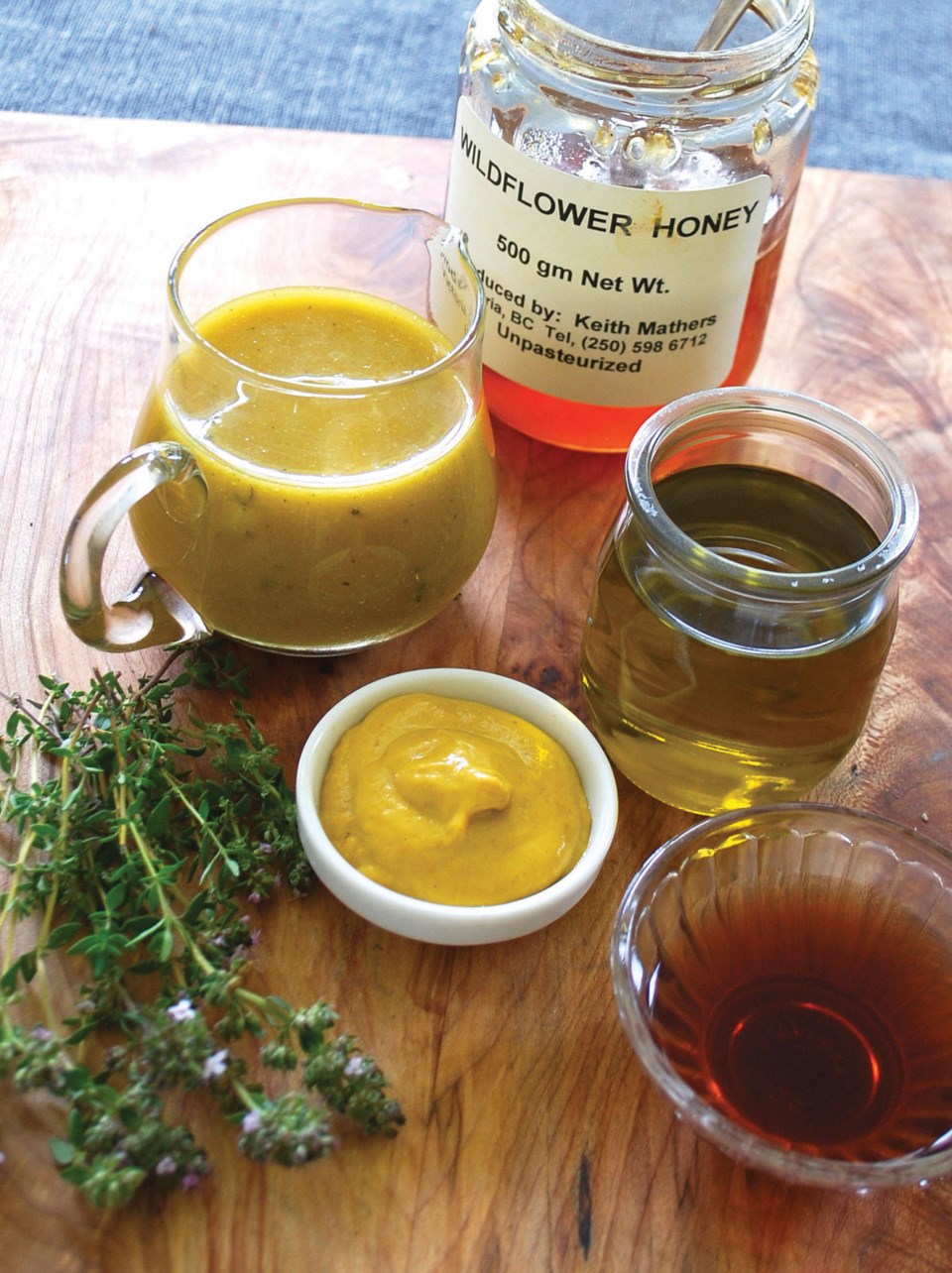 Dear Eric: In your article on vinaigrette you used Dijon mustard in the dressing. My question is, can you also use either dry mustard or prepared mustard? Does it make a difference to the emulsifying effect?
Dear Eric: In your article on vinaigrette you used Dijon mustard in the dressing. My question is, can you also use either dry mustard or prepared mustard? Does it make a difference to the emulsifying effect?
Frances
Frances’s question came in shortly after I answered another reader’s query on vinaigrette and why her dressing was separating.
The answer, published May 1, was because she was not emulsifying her vinaigrette properly and because of that, the olive oil in her dressing was rising to the surface.
Vinaigrette is a blend of oil and vinegar or other acidic liquid, such as lemon juice, that won’t blend together without the help of an emulsifier, and the preferred one is mustard.
As I noted in that article, according to the Saskatchewan Mustard Development Commission website, saskmustard.com, mustard seed’s outer coating is a compound called mucilage.
It says that mucilage has the ability to absorb and hold liquid, making mustard a good emulsifying agent with the ability to hold together liquids that normally would not, such as oil and vinegar, the latter being essentially flavoured water.
In that article, I noted that Dijon mustard is the most common type used in vinaigrette and that’s logical because this dressing is French in origin and so is that style of mustard.
But I should have also noted that other types of mustard could also be used to emulsify vinaigrette, including the two types Frances noted.
Dry mustard is simply dry mustard seeds ground into a powder that’s sold in tins by companies such as Keen’s, which also makes prepared hot mustard. The latter, sometimes called English mustard, is a condiment in which the seeds are blended with water and other ingredients into a smooth paste.
Both, as noted, are made from mustard seeds, so they obviously contain mucilage and therefore have the ability to emulsify vinaigrette.
These forms of mustard, though, are even more pungent than Dijon, and the vinaigrette you make with them will reflect that.
For example, at foodnetwork.com, I found a recipe by chef Tyler Florence for vinaigrette he used to dress salad greens.
To make it, he blended half a small chopped shallot, one tablespoon dry mustard, three tablespoons red wine vinegar and salt and pepper to taste, before whisking in 2Ú3 cup extra virgin olive oil. I made that vinaigrette and it emulsified beautifully, but it was very intense tasting, thanks to the dry mustard.
Some folks like that intense taste, but I prefer my vinaigrette to not be that bold.
That’s why in my recipe today, which uses hot prepared mustard, I decided to add a bit of honey to balance the mustard’s sharpness.
It, too, could be tossed or drizzled on salad greens accented, if desired, with raw vegetables, such as sliced cumber, radishes, tomatoes, celery and carrot.
In the column on vinaigrette, I noted that when making it the first step is to place the vinegar, mustard and flavourings in a good-size mixing bowl and whisk them thoroughly with a fine wire whisk.
Step 2 is to dribble and whisk in the oil very slowly. The constant whisking during this process breaks the oil into tiny droplets that become suspended, creating emulsified vinaigrette.
However, a few readers correctly informed me that, especially when making a large batch of vinaigrette, you could also do the mixing in a food processor or with a hand blender, saving you all that whisking.
Note: In next week’s column I’ll answer another reader’s question that also arose from my May 1 article on vinaigrette. That column will address how to use flavoured balsamic vinegars and flavoured oils in vinaigrette.
English Mustard, Wild Flower Honey and Thyme Vinaigrette
Spicy, slightly sweet, tangy dressing to drizzle or toss into mixed green salad or cooked, cold vegetables, such as asparagus or beans.
Preparation time: A few minutes
Cooking time: None
Makes: About 1 1Ú8 cups
1Ú4 cup red wine vinegar
2 tsp English-style hot prepared mustard, such as Keen’s brand
1 Tbsp wild flower honey (see Note)
• salt and freshly ground black pepper, to taste
1 tsp minced fresh thyme, or to taste
3Ú4 cup extra virgin olive oil
Thoroughly whisk and combine all ingredients, except oil, in a medium bowl. Very slowly, dribble and whisk in the oil to create an emulsified dressing.
Transfer vinaigrette to a tight-sealing jar and refrigerate until needed. It will keep at least a week. If the vinaigrette has started to separate during storage, to emulsify again, vigorously shake the jar, before opening and using.
Note: The very fine wild flower honey used in this recipe was bought at Victoria’s Moss Street Market. The vendor’s name is Keith Mathers. However, if you can’t get to that Saturday market, you could try another type of honey in this recipe.
Eric Akis is the author of eight cookbooks. His latest is The Great Rotisserie Chicken Cookbook (Appetite by Random House). His columns appear in the Life section Wednesday and Sunday.



